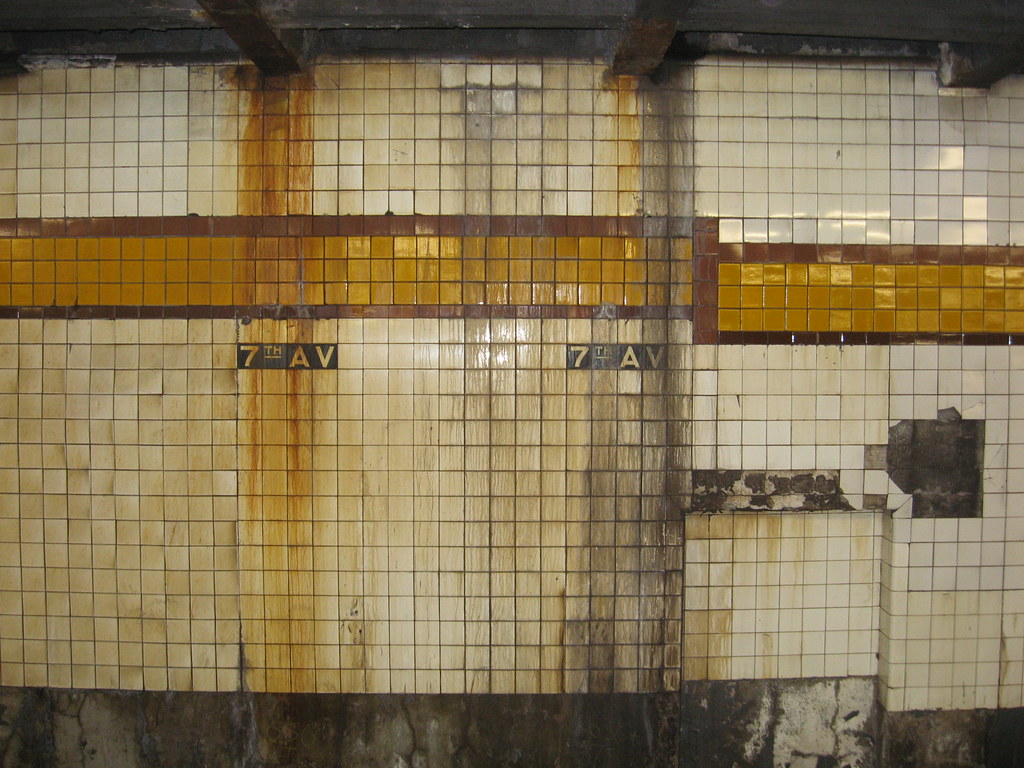The Seventh Ave. station on the IND Culver Line in Brooklyn has seen better days. (Photo by Benjamin Kabak)
Since 1904, the New York City subways have had an uneasy relationship with water. In some places, the subway system is only a few feet below ground, and ground water and rain have caused problems for subway operations and construction for over a century.
Today, the problems are more evident than ever. As the photo above shows, the F/G station at 7th Ave. in Brooklyn looks terrible, and it’s not the only one. The Manhattan-bound 2/5 platform at 149th St./Grand Concourse is marred with water stains (and worse). Various stations flood constantly. Walls bulge with water, and earlier this week, a disaster waiting to happen finally happened. Community groups and residents had long complained of the water damage at 181st St. on the West Side IRT, and last weekend, the ceiling finally gave way.
As the MTA has scrambled to restore 1 train service in Northern Manhattan, Transit has defended itself from accusations of maintenance neglect. The agency knew of the problems and complaints surrounding 181st St. and had even planned to fix it — next year. What of the other stations long wearing the visible scars of water damage? What of the walls and ceiling retaining moisture or worse?
In today’s Post, three reporters delve into the issue of water-damaged stations, and the findings are less than comforting. According to the Post, the Permanent Citizens Advisory Committee to the MTA recently reviewed numerous stations, and 16 of them received an F for “water-leakage problems.” Of those, three are scheduled for rehabilitation by 2015.
These stations, contend MTA officials, are not of the same vintage and architectural style as the 181st St. stop and do not pose the same risks. MTA Board member Andrew Albert is worried though. “I’m very concerned about it,” he said to the Post. “It makes me wonder if stations are being renovated on basis of need, or if they’re being clustered on certain lines so they can all be done faster at once.”
While the Post highlighted a series of stations in every borough with visible water damage, the MTA says that water was not the root of the problem at 181st St. and isn’t always reason for concern. “Water leakage, while a considerable problem throughout the system, is not necessarily by itself, a clear indicator of a severe structural problem,” Charles Seaton, a Transit spokesperson, said. “A recently completed system wide station condition survey identified defects at all stations, including ceilings.”
The agency has what the Post called an emergency fund to fix stations that present an immediate the safety risk, but in my opinion, that’s too little too late. We shouldn’t wait until stations on the verge of collapse to renovate and rebuild them. We shouldn’t have to wait until a ceiling collapses to question water-stained walls missing tiles and ceilings that look less that secure.
In a few days, the 1 train will be running again, and we’ll forget about the incident. Yet, the MTA will still need that money for routine maintenance, and if this collapse — a disaster that happened — doesn’t spur on more transit investment, what will?


6 comments
It is a good thing they hand out “Rider Report Cards”
http://whatyourdonotknowbecaus.....their.html
Water damage is not necessarily unsafe. At Seventh Avenue in Brooklyn, for example, the damage appears to be primarily esthetic — not that I’m excusing it, but it’s not in the same category as what happened at 181st St.
The MTA has been saying for years that much of the system is not in a state of good repair. That means components are liable to fail unexpectedly. What is worse, they have no plans to reach a SOGR for many years to come — not because they don’t want to, but because they’re at the outer limit of the level of funding they can get. This forces them to triage competing priorities.
As shown in the poll of New York City a while back:
People want a system in New York City, but dont want to pay for it with higher taxes or tolls.
Not sure what to do, its symptomatic of the entire country that wants something for nothing.
The whole tile concept is expensive to maintain… they crack, fall off, and depending on the corrosion have to be replaced instead of just cleaned. Where there is just one water leak, this can involve as many as 50 titles.
Except in the historic IRT stations, the MTA should look at plastic paneling, which could be offset from the walls enough to allow water and rust to flow behind them, providing for a much cleaner station look.
That’s exactly what they do — Seventh Avenue and 53rd Street on the IND, for instance, is so prone to leaks, that they finally just installed panels with a fake tile design and let the water run down behind them.
Oh, and the Post’s list is probably missing at least ten stations with worse decay. 21st Street and Broadway on the G come to my mind.